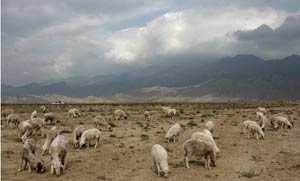 |
|
|
Serious devastation of
Alshaa Grassland
|
Chinese experts and scholars urged the government to improve its pasture management policies to better protect the interests of herders at an international anthropology conference held here Friday.
A group of experts on pasture management said the Chinese government should adjust and improve some of its policies in the pasture areas at panels on nomadic culture and development of the 16th congress of the International Union of Anthropological and Ethnological Sciences (IUAES).
Yang Li, economic and management professor of the Inner Mongolia University, said that some of the unequal grassland policies have left the herders vulnerable to land-use right violations.
China's reform was led by a group of villagers in the eastern province of Anhui that secretly abandoned the collective system and divided farmland among the households, which was at the time against Chinese law. Later, the practice was widely promoted as the household responsibility system across the country and triggered economic reform.
However, what works for farmland has not worked out so well for grassland, Yang said, adding that distributing the grassland to households has created many problems.
In the 1990s, the grassland-contract area was just a figure collected by the government, which existed only on the paper. Much rangeland in Qinghai and Tibet was symbolically distributed on the map to each household, but actually jointly used by herders, Yang said.
A survey released by the State Council Development Research Center's Rural Economy Department shows that China has 180 million hectares of grassland that have seriously deteriorated, at an annual speed of two million hectares. China has nearly 400 million hectares of grassland.
Many herders refuse to invest in protecting the grassland even though they are aware of the fact that their distributed grassland is deteriorating, because others can always use their grassland, he said.
Statistics from the Ministry of Agriculture shows that in 2008? 10 million mu (667,000 hectares) of contracted grassland was clarified, making the total amount of contracted-grassland area account for 74.3 percent of the total usable grassland.
Gai Zhiyi, professor of the College of Economic Management, Inner Mongolia Agricultural University, said that the unequal grassland use rights in the pasturing areas have hurt the interests of herders.
"The grassland use right of the herders is easily violated with the current policies," Gai said. According to Chinese laws, the resources above the grassland or underneath the grassland both belong to the state. Once the state discovers resources under the grassland and decides to exploit, it is almost impossible for the collective to negotiate for their collective grassland use right, he said.
Meanwhile, if trees are found in pasturing areas, the forestry department can issue certificate of forest, which overrides the certificate of grassland use right. Some herders in Hulunbeier, Inner Mongolia, chop down the saplings they see when they are grazing on the grassland because if the sapling grows into trees, they will lose their grassland to the forestry department, Gai said.
China has launched a series of projects to enhance ecological preservation and improvement in grassland areas. These projects include returning reclaimed land to forest, returning grazing land to grassland, protection of natural forests, harnessing sources of sandstorms affecting Beijing and Tianjin and conservation of soil and water.
Although the grassland eco-environment has improved thanks to the various projects initiated by the government, it faces great challenges in preventing the grassland from over-grazing, exploitation, requisition, desertification and disasters caused by mice and other pests, according to a report on China's grassland released by the Ministry of Agriculture in April this year.
Some of these projects are still under debate, said Chen Xiangjun, from the anthropology department of Sun Yat-Sen University.
Take the ecological resettlement project for example, which resettles herders from the grassland to prevent the grassland from deterioration. But agriculture is different from stockbreeding and the herders know nothing about farming, Chen said. A project in the Alxa area in Inner Mongolia ended up with herders going back to grazing on the grassland, he said.
Some of the officials in pasturing areas do not understand the pastoral culture and make rash policies using simplistic rationale to deal with very complex problems, said Prof. Gai.
They need big projects as their political achievements on their resume so they can climb higher in the political ladder, that is why they do not care too much about the long-term interests of the herders as well as the grassland, he said.
Gai suggests the policy makers consult experts from different fields, economics, religion, ethnic studies, pastoral culture as well as local herders, who conduct long-time research in the area to make policies concerning the pasturing areas.







